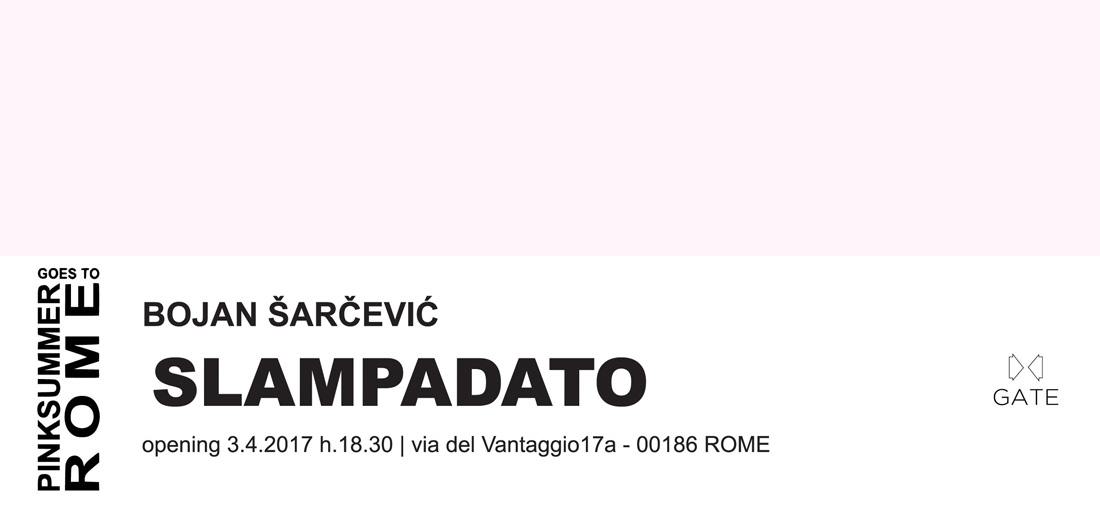Slampadato – Bojan Šarčević

Press release
A body that moves within a space is an action that turns the space into a place, a place always has a load of symbolic meaning, which implies the planning of living. In that sense, a place is a space perceived by a body through its sensory apparatus, eyes, ears, nose, epidermis… The idea of a place somehow implies the concept of “limen”, passage, threshold, orifice. Even though tactility oriented world is linked to the sight oriented one through the abstraction of past experience memories, tactility world seems indeed more comfortable than the sight one, because it keeps the body in closer contact the place it inhabits, the place where it acts. the no matter if that is a room with ceiling or an atmospheric space topped by the sky. In his “The Hidden Dimension” Edward Hall quotes the anthropologist Benjamin Lee Whorf who, in “Language, Thoughts and Reality”, asserts that in hopi language, the one of native Hopi tribe living in desert plains of north Arizona, the word “time” does not exist, being time strictly connected with the idea of space, and to the Hopi space is something deeply real. Hopi people cannot imagine, nor describe in their language places such as paradise or hell. Although that people construct sturdy stone houses, their language has no word to name three dimensional spaces as they were things such as the corridor or the entrance of a house, that in their language are indicated as localizations.
Bojan Šarčević has always claimed that the magic of an artwork is on the edge with the impossibility of its description.
All his works seem to recall bodily and relational experiences, caressed by a sensual and sofisticated formal approach, centripetal and absolutely pure, captured by texture and by the visual and tactile imagery triggered by texture itself.
Sometimes his work tends to create some sort of sensory frustration, that can be provoked in non-narrative terms by the sculptural allusion to furniture pieces, or by juxtaposing some cold and uncomfortable material to some soft and sensual ones. In the setting designed for the exhibitions “In the Rear View Mirror”, “Invagination” and the current “Slampadato”, Šarčević recognizes only the kinesthetic perceptive horizon. Announced in the actual linguistic onomatopoeicism of his last two exhibitions and established in the show at pinksummer goes to Rome through the intention of suppressing any intermediation, no matter if the image on the invitation card or, even worst, the press release, he does so as if a precast verbal world could prevent a deep perception of the work and the sensual and intimate magic of its hidden dimension.
We wrote such a long preamble just to tell that our press release, for what it’s worth, exists only because pinksummer is a bit like the aboriginal Australian described by Bruce Chatwin in “The Songlines”, who imagine that things are drawn into existence by singing, while us, being unable to sing, we write.
We could also tell that Bojan Šarčević “Slampadato” refers, perhaps by coincidence, to a surrealist exhibition curated by Marcel Duchamp at Lelong gallery in Paris in 1947, in which he installed a watering system on the ceiling sprinkling water onto the wooden floor, letting the sculptures by Maria Martens, who was Duchamp’s lover at that time, get wet.
Finally, “Slampadato” made us think at “Le bain Turc” painted by Jean-Auguste-Dominique Ingres when he was 83 years old, namely at what inspired the artist, the description of the Turkish bath written by Lady Mary Wortley Montagu, English ambassador in 19th century Turkey: “I believe in the whole there were 200 Women (…) The first sofas were cover’d with cushions and rich carpets, on which sat the Ladys (…) all being in the state of nature, that is, in plain English, stark naked, without any Beauty or deffect conceal’d, yet there was not the least wanton smile or immodest Gesture amongst ’em (…)“


